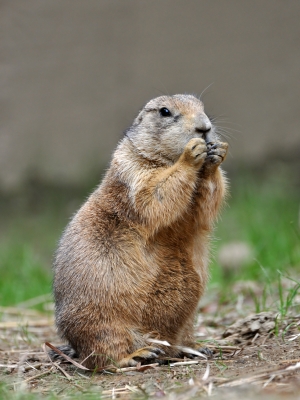
Prairie dogs excavate elaborate burrow systems with many entrances marked by low or volcano-shaped mounds. The common black-tailed (C. ludovicianus) and Mexican (C. mexicanus) species live in large, dense colonies that early explorers described as “towns.” Colonies are divided by topographic and vegetational features into semidiscrete wards formed from smaller extended family groups, or coteries. Colonies usually cover about 100 hectares (247 acres), but the largest ever recorded was a black-tailed prairie dog colony in Texas that formerly stretched across 65,000 square km (25,000 square miles) and contained an estimated 400 million individuals.
During the day, foraging above ground is the principal activity. Succulent parts of herbs and grasses, leaves, and new shrub growth are eaten in the spring, and seeds are the primary component of the summer diet, with stems and roots being the mainstay in fall and early winter. The black-tailed and Mexican prairie dogs do not hibernate and are periodically active during winter; they do not store food in their burrows. During winter when food is scarce, black-tails remain in their burrows for long periods without food or water, using physiological adaptations to control their metabolism. The other three species become torpid in October or November and emerge in March or April. Late winter or early spring is the breeding season for all species, and after about a month’s gestation, females drop a litter of up to 10 young. Communication takes the form of alarm calls (repetitious barks and chuckles), threats (snarls, growls, and tooth chatters), and distress calls (screaming); individuals enhance group cohesion by greeting one another upon contact, using vocalizations that are specific to each species.
Natural predators of prairie dogs include badgers, wolves, coyotes, bobcats, black-footed ferrets, golden eagles, and large hawks. Once abundant, prairie dog populations have been drastically reduced in range and number by poisoning programs of ranchers who have considered them as pests and by conversion of habitat to cropland. The black-tailed prairie dog (C. ludovicianus) is the most widespread, living throughout the Great Plains from Canada to northern Mexico; Gunnison’s prairie dog (Cynomys gunnisoni) occurs where Arizona, Colorado, New Mexico, and Utah meet; the white-tailed prairie dog (C. leucurus) is found from eastern Wyoming through intermontane Rocky Mountain valleys to the eastern margin of the Great Basin; the Utah prairie dog (C. parvidens) is restricted to the southern part of that state; and the Mexican prairie dog (C. mexicanus) occurs in northern Mexico.
Credit : Britannica
Picture Credit : Google




